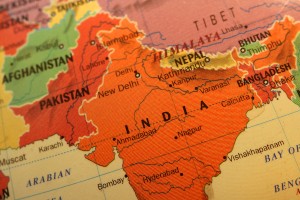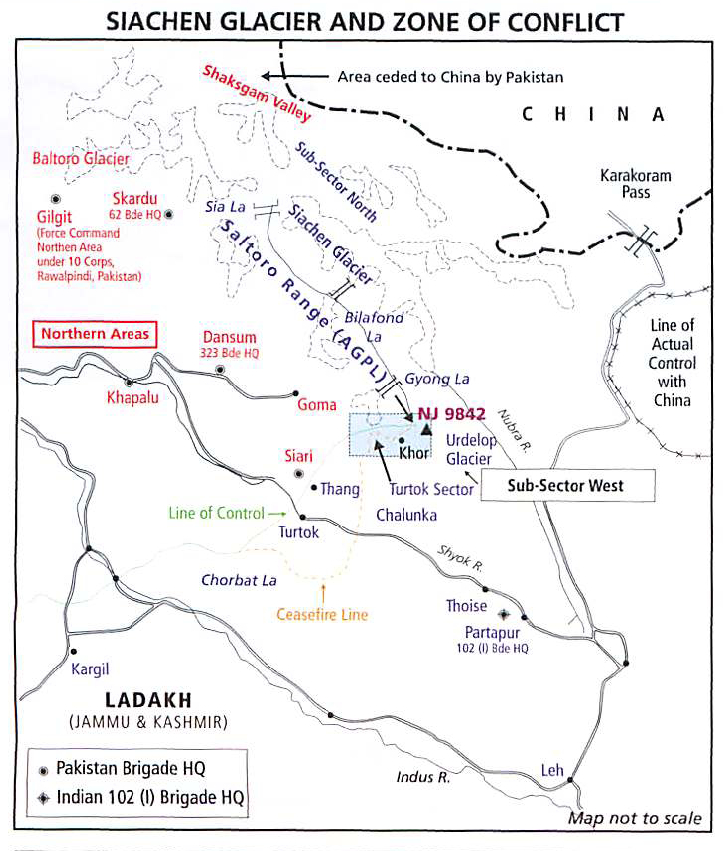6/12/12: By Robbin Laird
In a recent issue of Force magazine, an Indian colleague provided an insightful analysis of a key axis point where the combined Chinese-Pakistani threat could combine to pose a significant strategic challenge to India.
In their article: Can Siachen Spring the Next Surprise? Pravin Sawhney and Ghazala Wahab assessed the nature of the threat.

After the 1999 Kargil war and the 26/11 terrorist attacks in Mumbai, can Siachen spring the next surprise for India?
Sounds impossible, all regular analysts would say. The arguments to back this assertion would be that the 28-year-old conflict has stabilized operationally, with little hope of either side making tactical gains. Both sides are keen on demilitarization, which would be a powerful confidence building measure towards the Kashmir resolution.
Both sides continue to lose troops to weather than combat, which has ceased since 26 November 2003. The only thing that is preventing the pullback of mutual troops is the trust deficit between India and Pakistan. A move-back from this futile battlefield would provide a gigantic fillip to the lack of mutual trust.
The powerful factor to change the existing realities could be China. Numerous media reports in 2011 have written about 10,000 Chinese in Northern Areas (NA), purportedly for building of infrastructure there.
It has also been reported that the 1978-built Karakoram Highway which connects Chinese Xinjiang with NA over the 19,000 feet Khunjerab pass well north of the Siachen glacier is to be developed into an all-weather road with Chinese help. What should alarm India, however, is something else.
The Indian COAS, General V.K. Singh in 2011 spoke about the presence of nearly 3,500 Chinese People’s Liberation Army (PLA) personnel in Pakistan Occupied Kashmir (POK). As an aside, when FORCE recently asked a senior general responsible for Kashmir theatre what could be the implication of this development, he said that his dual responsibility was counter-insurgency and anti-infiltration across the Line of Control.
People in Delhi should worry about Chinese troops in POK, he added.
If anything, his remarks betrayed a lack of understanding of the influence of geo-politics (geography’s influence on relations between nations) on military dynamics, which has propelled power-play in this region since centuries.
http://www.forceindia.net/CanSiachenSpring.aspx
The article discusses how a de facto alliance between Pakistan and China could pressure India and create a very difficult military situation for India. The map below provide a good look at the intersection points.
And as the author’s argued:
The Pakistan Army could attempt to recapture NJ9842 (surrounded by three distinct glaciers, Gyong, Urdelop and Korissa( in sub-sector west presently held by India, and the PLAT could sever India’s operational logistics by land and air maintenance to Sub-Sector North (SSN) facing the Chinese in Ladakh.
The authors conclude their assessment by looking at what India needs to do to prepare for such a contingency.
Should the Chinese decide to back Pakistan to push the NJ9842-Karakoram line, India will need to be prepared for a limited war in time and space. Combined, the two allies have the capability to dare and accomplish this. As India will hesitate to broaden the war to include Kashmir, where a ceasefire holds, let along allow itself into an all-out two-front war for which it lacks both political will and military capabilities… The Indian Air Force will need to play a supportive role ot the land forces as otherwise the war would not remain a limited one.
In an interview with Pravin Sawhney at the Airbus Trade Media event during May 2012, the co-author of this article outlined his broad concerns about the evolving Chinese-Indian military balance.
For Sawahney, the key disconnect was that the Indian forces were thinking in an older land-centric manner, while the Chinese embracing in a very different approach to the battlespace.
“There are five key dimensions to the Chinese effort where the Indians are nowhere close to them in capabilities. The five dimensions are cyber, space, ISR, special forces and ballistic missiles.”
Sawhney argued that the “Chinese are looking at a different battlefield than is India. The Indians are looking at the problem as a classic ground campaign or challenge.”
His concern about the slow pace of the modernization of the Indian Air Force was highlighted in his thinking about the need to deal with the Chinese challenge and the potential for convergence of a Pakistani and Chinese threat scenario.
In the discussion, Sawhney underscored that the reach, speed and mobility of the IAF was crucial to the ability of India to defend its territories. This is not a classic Army problem, but should be seen as a challenge requiring a new approach, one which say airpower and its related capabilities as a key response.
Credit Map Graphic: Force Magazine


